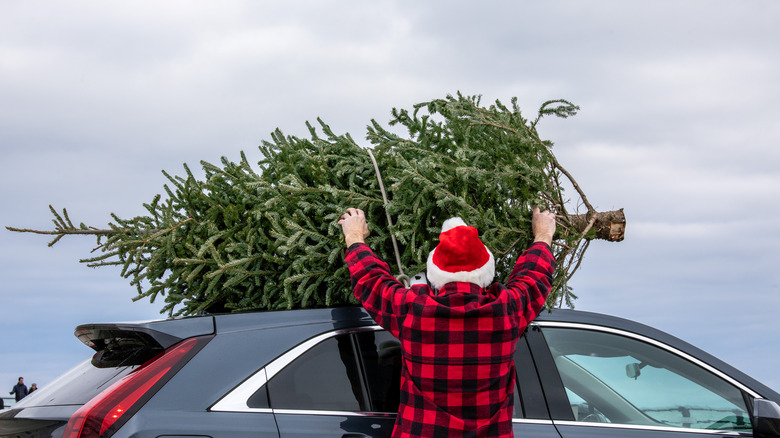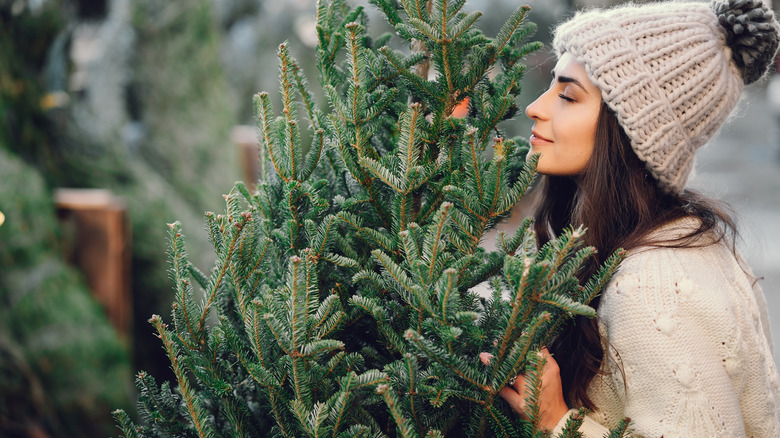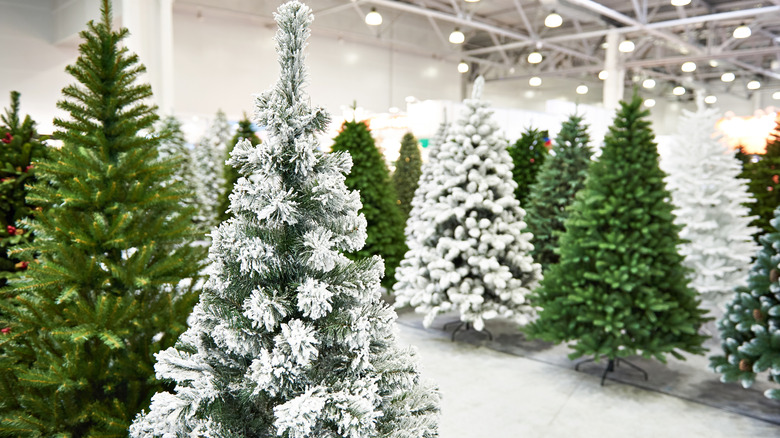Real Holiday Trees Vs. Fake: What Are The Pros And Cons?
When choosing a tree for your family's holiday celebration, there are almost too many options to count! Whether you prefer a living tree or a reusable artificial, there are pros and cons to all of the choices available.
If you are someone who prefers a real, fresh-cut tree, there are multiple popular breeds, including Scotch Pine, Sugar Pine, White Spruce, Norway Sprue, Blue Spruce, Balsam Fir, Douglas Fir, Noble Fir, and Fraser Fir (via Balsam Hill). Each of these provides your home with a classic charm, a lovely scent, and the particular magic of bringing the outdoors indoors during a season where we spend a great deal of time inside.
That said, once you choose your preference in fresh tree type, there are several things you ought to take into account to ensure that your tree remains healthy and beautiful throughout your celebration season. While some people feel this extra work is worth it, others might consider it a "con" to choosing real Christmas trees.
What you need to know about real trees
The first thing to consider when choosing your real tree is where you decide to buy it. Just like any other fresh-cut vegetation like flowers or vegetables, your best bet to getting a tree in the best possible shape that will last the longest, is to ensure it was cut very recently and very close to the location where you are buying it (via Good Housekeeping). Of course, the ideal situation would be cutting your tree yourself, which many tree farms allow customers to do. Realistically, not everyone has access to such a farm, and so going to a tree lot is your next best bet.
Doing some research to learn where the trees at your local tree lot come from can pay off, as you want to choose a tree that has travelled as short a distance as possible, thereby ensuring a fresher, healthier tree. Once you choose where to buy your tree, there are a few ways to make sure you are picking the cream of the crop. First, choose a tree that is resting somewhere shady, rather than one that has been sitting in the sun for days. Next, don't be afraid to get your hands dirty by checking the health of the tree by touching it. When you touch the branches, the needles should not come off in your hand, and most should be a healthy green.
The care of a real tree
Before you leave the tree lot, it's also a good idea to check the tree as best you can for bird nests or insects. Remember, until it was cut, this was a living tree outside on a farm, and local animals likely treated it as such.
Once you get your real tree home, you want to make sure to take proper care of it to ensure its longevity. Keep a spray bottle on hand to gently spritz your tree daily, and of course, you need to make sure the base of the tree has water at all times (via Home Depot). While a simple tree stand with a reservoir in it will do the trick, if it's tough for you to remember to check the water level every day during this busy season, there are other options.
For instance, you can purchase various types of automatic tree waterers, some of which simply alert you when the tree is getting dry so you can water it, and others are actually equipped with a tubing system to do the watering for you. When your tree is newly cut, it is likely to soak up a great deal of water, but it will slow down as the tree nears the end of its life and the end of the holiday season.
If all of this sounds like a little too much of a hassle, there are plenty of beautiful, reusable man-made trees to choose from!
The deal with man-made trees
If that all sounds like too much work, you could choose a reusable, man-made tree. Benefits of an artificial tree include the fact that you can re-use it every year, it prevents any allergic reactions for people with sensitivity to trees, and artificial trees often come pre-lit, cutting down on some work. Setting them up is simple, you don't have to water them, and they won't drop needles as the season goes on. You can shop for them in person at your local big box, hardware, or other stores, or you can shop for them online at several retailers.
The downsides to fake trees include the fact that most are not recyclable, as they tend to be made with PVC, which a petroleum-based material (via The Family Handyman). This means that when you eventually decide to discard your fake tree, it's likely to end up in landfill, which is not environmentally friendly. Further, while buying real trees supports local farmers, most man-made trees are created overseas.
The most important thing, of course, is to choose a tree that is best for your own family's safety, priorities, and comfort, whether that is a real tree or a fake one. Happy holidays!



